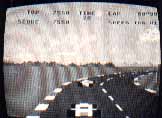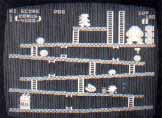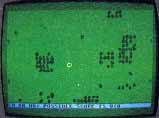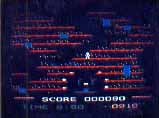TWO FROM ATARI

POLE POSITION
P.O. Box 427
Sunnyvale, CA 94086
(408) 745-2000
$49.95, 16K -- cartridge
Reviewed by Brian Ho Fung
Pole Position has just been released by Atari as a successful adapation of the popular arcade game for its home computers.
In Pole Position, you control a grand prix racing car, competing against computerized drivers in a race against the clock. You steer the car by pushing the joystick to the left or to the right. The fire button takes the place of the brakes. Push the joystick forward to put the car in low gear, and pull it back to shift to high.
As the Atari blimp passes overhead, you begin the gnme by attempting to qualify for the race. Your point of view is located at eye level, immediately behind your car. You slam down on the gas and begin the race along a realistic scrolling raceway with a mountain landscape in the background. You are now attaining speed (maximum 195 mph) and cruising along the straightaway. Pretty soon, you encounter a car just up ahead and you swerve to the right to pass it. Oh no! You lose control of your car and run off the track right smack into a billboard! Valuable seconds tick away while you get your car back onto the track to continue the race to the finish line. To qualify, you must place among the top eight cars (i.e, finish the lap in less than 74 seconds).
If you do manage to qualify, you are again placed at the starting line (according to how well you qualified) to begin the actual race. The race is identical to the qualifying run except that you must finish a certain number of laps, each within a certain amount of time.
Pole position allows you to select up to four different courses: Atari Grand Prix, Malibu, Indianapolis, and Practice Run (no cars). You can also determine the number of laps for each race (up to eight) to increase the challenge of the game. Depressing the space bar momentarily pauses the game.
Pole Position's graphics are exceptionally well done. The cars are multi-colored and the mountain landscape is very realistic. The games sounds are also excellent. You can hear the roar of the engines and the squealing of the tires. The many hairpin turns and dangerous obstacles make this a very difficult game.
Pole Position will challenge and entertain you for hours on end, and I highly recommend it.

DONKEY KONG
P.O. Box 427
Sunnyvale, CA 94086
(408) 745-2000
$49.95, 16K -- cartridge
Reviewed by George Adamson
Why did Atari wait until a year after Donkey Kong peaked in popularity to release its 16K KOM cartridge version ofthe game! Colecovision muscled into the home video market in 1982 on the shoulders of the oversized ape, with resolution surpassing anything on the home market. True arcnde fans were quick to note how far "Kong" fell, however.
Though a latecomer, Atari's Donkey Kang is just about the most faithful reproduction of an arcade game that we've seen for home use. All versions of Kong challenge Mario, the carpenter, to rescue his lady love from the clutches of the giant gorilla who seeks sanctuary higher and higher atop an unfinished skyscraper. But it's the attention to detail that sets the Atari version apart from its cousins -- from Kong baring his teeth and shaking his fists to the "halo" above Mario when he gets clobbered (as he inevitably will).
The first screen finds Kong at the top of the lowest structure, heaving barrels in all directions. Not only does Mario have to jump rolling barrels, but he has to beware of barrels falling vertically. On higher levels Kong even tosses barrels diagonally. On Colecovision the barrels just roll off the screen, but on Atari they crash into the burning oil drum (animated in the Atari game) and turn into deadly foxfires that seek Mario out.
The "rivet" board is designed differently from Colecovision, having five rows of girders and ten rivets to be popped out (Coleco had eight). There is plenty of animation as the girl darts from side to side, and Kong stomps and snorts. If all rivets are removed, Kong falls on his head.
The elevator sequence really gets wild as Mario must not only time his jumps to avoid falling or being singed by foxfires, but he most dodge the mad "springies" to reach his goal.
Colecovision may have an edge in resolution, but Atari's Kong is more ferocious looking, and his grunts sound worse than an 810 disk drive. Atari players see the girl scream "Help!" They see Marios heart glow when he reaches the girl, and split in half when she disappears. Just like the arcade original, the Atari version asks the question, "How high can you go?" and stacks Kongs after each board has been conquered. And yes, fans, Atari does have the fourth screen with the conveyor belts.
Atari displays the high score attained during the session. If you've mastered Colecovision and expect to manhandle Atari's Kong, are you in for a surprise! My son racked up 380,000 on Colecovision but only about 80,000 on Atari. I could reach the third board on Colecovision, but I found even that to be a rare accomplishment on the Atari version. Each screen has so many actions and so many variables that the game just doesn't get monotonous.
Move over, Pac-Man. Atari has a really "heavyweight" champ!
TWO FROM PARKER BROTHERS
Q*BERT
50 Dunham Rd.
Beverly, MA 01915
(617) 927-7600
$39.95 8K -- cartridge
Reviewed by David Duberman
....When I regained consciousness, I found myself atop a pyramid of enormous blocks. I had somehow been transformed into an unsightly kiwi-like little creature, more nose than anything. But oh, I could leap! One hop would carry me to the top surface of any adjacent cube one row up or down. Soon I found that I could make apparent progress, merely by changing the top surface of each block in the pyramid to a certain color. The color was indicated to me by a flag that appeared in a cloud. This I accomplished by leaping onto and off of each block a certain number of times, the number depending on how far along in the sequence I was. At this, a peal of chimes would sound in the distance, and I would find myself at the top of a fresh pyramid. So I had found a purpose in life, of sorts, and was content ..
If you arcade freaks recognize the scenario of Q*Bert, let me add that Parker Brothers has produced here one of the finest translations of an arcade game for the home computer format. Everything is replicated - all the familiar enemies and the friendly Green ball, even the whirling flying discs stationed at the pyramid's edge. About the only thing missing is the sound of Q'Bert's mumbled curses when he drops off the edge or encounters an enemy. You still see the cartoon ballon, though.
The enemies are all cute, but deadly. Red Ball and Purple Ball bounce downwards and squash you if contacted. If Purple Ball reaches the bottom, it turns into Coily, the snake, and pursues you mercilessly about the pyramid. Ugg and Wrongway appear out of nowhere and jump sideways and upwards. Sam bounces downwards and attempts to undo your work, changing blocks back to their original color. Only Green Ball helps you -- touch it and all the enemies are frozen momentarily.
At higher levels, changing all the blocks to the correct color can be exceedingly difficult without a specific strategy. This is because once a block has become the target color, additional contact causes it to change to the original or an intermediate color, often necessitating numerous retracings of your path.
Q*Bert is a fascinating game to play. The feeling of realism created by the play mechanic is uncanny. After playing for a few minutes, you actually start to believe you're bouncing around on a three-dimensional pile of blocks. It's a truly great game, and I think the reason is that you hardly ever lose a life through bad luck, and you know it. You'll usually see a way you could have avoided disaster. If you had only ...
SUPER COBRA
50 Dunham Rd.
Beverly, MA 01915
(617) 927-7600
$39.95 8K -- cartridge
Reviewed by David Plotkin
There are a number of classic video arcade titles that have never been released in the home computer format. One of the best of these, Super Cobra, is now available on cartridge from Parke Brothers. The game is very well done, with good playability and graphics; Parker Brothers' high staIldards in board games have evidently been carried over to its home computer games.
Super Cobra is a left-to-right scrolling game similar to Scramble. You pilot a heavily armed helicopter with your joystick. You must navigate through caverns and across hostile landscapes fairly bristling with missiles, tanks, and other obstacles. Your goal is to get through all ten of the thousand-mile segments and steal the treasure chest at the end. If you succsed, you start over at a higher difficulty level.
The hazards in Super Cobra are many. Missiles are launched upwards to shoot you down, tanks fire, and stationary and moving mid-air projectiles block your way. You must also destroy fuel dumps or risk running out of fuel. Probably your most difticult task, however, is to navigate through some very tight spots in the caverns. The screen is in constant motion. You can advance your helicopter to about the center of the screen or back off to the left edge of the screen, but you can't stop. You start with five choppers, and a new one is awarded periodically.
Your helicopter's weapons are activated by pressing the fire button: bombs drop in a forward lob and guns fire forward. As many as four missiles can appear on the screen at once. You can destroy only enemy installations with your weapons -- the ground and cavern walls are impervious.
Super Cobra makes excellent use of the Atari`s special features, such as Player/Missiles, smooth scrolling and redefined character sets. The graphics are sharp and colorful. Clearly, here is a company that comprehends the difference between the VCS and the home computers. I look forward to more of their releases.

COMBAT LEADER
883 Stierlin Rd., Bldg. ,A-200
Mountain View, CA 94043
(800) 772-3545, ext. 335 (inside CA)
(800) 227-1617, ext. 335 (outside CA)
$39.95, 48K - cassette or disk
Reviewed by Edward Bever
Combat Leader, SSI's latest release in its "Rapid Fire" series, puts you in command of a mechanized squad, platoon or company. You direct the movements of tanks, armored personnel carriers, and infantry fire teams across a scrolling landscape of hills, woods, rocks, and depressions. The computer controls the enemy forces, which flicker in and out of view as they enter and leave your troops' line of sight. The weapons available include rifles, machine-guns, anti-tank guns and missiles, mortars, and tank cannons. To win, you must maneuver your forces to make optimum use of their weapontry while avoiding enemy fire. The program includes six scenarios, in addition to which you may design your own.
Despite certain simplifications and inaccuracies concerning armament organization, Combat Leader achieves a fundamental form of realism: it recreates the feel of the situation it simulates and gives you a sense of the uncertainties and imperatives of modern tactical combat. In order to survive and prevail you must employ tactics similar to those used on the real battlefield.
Combat Leader is by no means simple to master, but it is a pleasure to play. The graphics are excellent, the machine language program executes instantaneously, and the two-keystroke commands are easy to learn and employ. Units are often difficult to distinguish and it is not uncommon to issue the wrong commands, but these difficulties are probably intentional. Combat is inherently confusing, and one of the biggest problems with board and early computer war games was the unrealistic amount of information a player had about the enemy. Combat Leader recreates some of the chaos of tactical combat in a way that does not really make the game any more difficult to play, just more difficult to win.
Combat Leader is not the definitive simulation of modern tactical warfare, but it is an engrossing and enlightening game. I recommend it highly to all war gamers and to anyone else who enjoys a fast paced, challenging battle of wits and reflexes.

MOUNTAIN KING
601 Doremus Ave.
Newark, NJ 07105
$39.95, 8K -- cartridge
Reviewed by Bryan Welch
Deep inside a longlost diamond mine lies the priceless crown of a long-lost civilization, awaiting an explorer courageous enough to take it. In Mountain King, your challenge is to seize the crown and escape with it to the top of the mountain, where you will he proclaimed (trumpet fanfare, please) Mountain King!
The graphics in Mountain King are not breathtaking, but are used cleverly enough to suggest the inside of a mountain, with a mystical touch.
Your first goal is to collect 1000 "diamond points," by jumping from ledge to ledge, picking up diamonds along the way.
Once you have reached this goal, you must locate the Flame Spirit. Don't try to find it on the screen, as it is almost invisible. Ignore the screen and listen for the theme music. The louder the music the closer you are to the Flame Spirit. When you feel you are at the spot where the music's volume is at its peak, use your flashlight to find and capture the Flame Spirit.
Offer the Flame Spirit to the spirit guarding the temple, and it will allow you to enter and take the crown. This, however, is just the beginning of the battle, as now you have only 45 seconds to climb back up to the top of the mountain!
The main quality that makes Mountain King a winner is its music. As you race to the top of the mountain with the crown, the theme song plays with driving urgency, pushing you to climb faster and faster to reach the top in time. When you near the peak, the music plays at a frantic pace, causing you to make mistakes as you try to climb too quickly. The driving force of the music is impossible to ignore, and the overall effect is riveting. Many games have theme music, but in no instance has a game used music as so integral an element.
Mountain King is an outstanding game with an original idea and a tinge of mystery. If you like arcade-type games with fantastic music, then Mountain King is for you!
THE BEST OF ACE #1
c/o Chuck and Judy Ross
2222 Ironwood
Eugene, OR 97401
$15.00
16K - cassette, 24K diskette
Reviewed by Fred Pinho
The Atari Computer Enthusiasts (ACE) is one of the oldest and best known of the many users groups. Their monthly newsletter enjoys world-wide distribution, and carries a variety of reviews, "hot" news and high-quality games and utilities. Many of the games make extensive use of machine language for "arcade" action. The Best of ACE #1 is a collection of games and utilities from their early 1983 newsletters. Available on disk or cassette, the package has a variety of games with good graphics and sound.
As with much public-domain software, documentation is minimal, so you must experiment to discover all the features of each program. Some additional documentation plus a wealth of reviews and news can be obtained by ordering the ACE back issues (February through March 1983). These cost $2 each and are well worth the price.
Following is a brief description of the best games and utilities in the package, along with some hints on requirements for each.
Crickets (24K BASIC) Is a Frogger-type game, with cute graphics and sound, in which a male cricket must bring gifts to his love waiting on the other side. He must jump from conveyor, avoiding any objects on the them and objects thrown by a jealous suitor. He then must turn around and get another gift.
Wild West is modeled on Activision's Kaboom. Dynamite Dan is dropping bombs on you. Move a sombrero with your paddle to catch them before they explode. The graphics, while simple, are colorful, and the action at the higher difficulty levels is fast and furious.
Old MacDonald is a delightful game for young children. It is designed to help them learn to count and match groups or patterns. A correct choice rewards them with a "smiley" and a little tune. An incorrect choice results in a "frowner." Getting ten smileys results in the full tune of Old MacDonald being played. Beautiful character graphics are used to display the animals to be counted or matched. An easy-to-use menu lets the child choose setup conditions. All three of these games were written by Stan Ockers, an "ace" programmer.
Also included is a GTIA joystick painting program, by Scott Berfield, which allows you to draw detailed pictures in any of the GTIA modes and save your pictures to disk or to a printer (Microprism or Epson MX80). Included are two picture files, including a beautiful drawing of the space shuttle. The BASIC program is not fully userproofed (you can cause errors to occur), but it has great power.
If you're adventurous and willing to experiment, the programs in this disk will give you an exposure to a variety of games and a great utility at a minimal price. Overall I rate this a software "best buy."
DOS-MOD
1058 Marigold Ct.
Sunnyvale, CA 94806
(408) 246-8325
$35.00, 16K -- disk (single density)
$50.00, 16K - disk (double density)
Reviewed by Larry Dziegielewski
DOS-MOD is an Atari Disk Operating System (DOS) enhancement which gives the user a more powerful, easier to use DOS. It fixes all of the known bugs in Atari DOS, and adds many advanced features usually found only in systems running on much larger machines. Until now, Atari Disk Drive owners have had DOS 2.0 or OSA + to handle their disk I/O chores. While Atari DOS is good, it has a few areas which could stand improvement. This is where DOS-MOD steps in.
DOS-MOD is packed with features including three new commands.
The P (run program) command begins execution of a program in memory. The P command differs from the M command in the default address used to execution. With M, when no address is specified, the address of the last load binary file is used. With P you can specify the default address by typing P [hex address]. As an example, programmers could use P to access a debugging file already in memory, work in that file, and then switch back to DOS.
The Q (command file) command creates a file of DOS commands that can be executed later with a single line command. This can greatly simplify the implementation of commonly used commands by grouping them into one or more files.
The R (read/store memory) command can be used to examine and change hex addresses in memory. In response to the command R [hex address], DOS will print the requested address and display the eight bytes of data starting at that memory location. Typing S will repeat the action and allow you to type in new hex values for that address. Pressing [RETURN] stores the new values.
DOS-MOD also comes in a double-density (DD) version which is compatible with most standard DD formats that understand the Percom protocols. The DD version has a few added features not found in the SD version. The I, command now has a /M option which when executed will display the hex location of the memory areas loaded. Using this option you can see which areas of memory are occupied by a binary file. There is also a HELLO command file option which is executed automatically each time you boot DOS. With the HELLO file, you can put in any message, including any DOS commands needed to set up your system to suit your needs. This is a most useful feature. Lastly, the DD version has a cartridge-bypass feature, which lets you bypass any installed cartridge when booting and go right to the DOS menu. The DD version can also run in the SD mode.
DOS-MOD has one of the best tutorials I have seen in a long time. It guides you step by step th rough the program features, encouraging you to try out the new commands as you go along. The tutorial is fairly lengthy. When dumped to a printer, the text fills 48 sheets of printer paper. It should be noted that DOS-MOD comes without a manual, only a command summary booklet. Therefore, it is necessary to keep a copy of the printout on hand for detailed information.
DOS-MOD is fast, easy to use, and is extremely powerful, but most of all, a bargain. In my opinion, the tutorial alone is worth the purchase price, making DOS-MOD a best buy at the software market.
HOME-CALC
1100 E. Hector St.
Whitemarsh PA 19428
(215) 825-4250
$29.95, 16K -- tape
$39.95, 24K -- disk
Reviewed by Jordan Powell
Home-Calc is an inexpensive spreadsheet program well suited for use in the home. VisiCalc, the only other spreadsheet available for the Atari, is expensive and contains features not needed for home application.
The program comes with a special key which must be inserted into joystick Port 1. BASIC is also required.
Once the program is loaded, it checks the amount of memory it has to work with and then calculates the number of cells available to you. A cell is a position on the spreadsheet in which you can put the numbers you are working with, or column and row labels. You are then asked how you want to arrange the number of cells available (how many rows by how many columns). Alphabetic labels, numbers and formulas can be entered into the cells. Formulas allow you to use the contents of one or more cells to calculate the contents of another cell. You can enter formulas using the four basic arithmetic operations and exponentiation. There is also a "sum" function which will add up any row, column or block of cells. To move to different parts of the spreadsheet, you can use the arrow keys or the GOTO command for rapid repositioning.
The disk version of the program permits replication of the contents of a cell in another cell or block of cells. Templates, which are forms where the relationships between cells, their values and labels are stored, can be saved and loaded in both versions and the spreadsheets can be printed. The disk version also allows you to look at the disk directory while loading and saving templates.
In summary, Home-Calc is useful and well worth the money. The documentation is easily understood and the capabilities are adequate for home use. I use Home-Calc to do my family budget and other financial calculations and it saves me time and helps me to better analyze my finances.